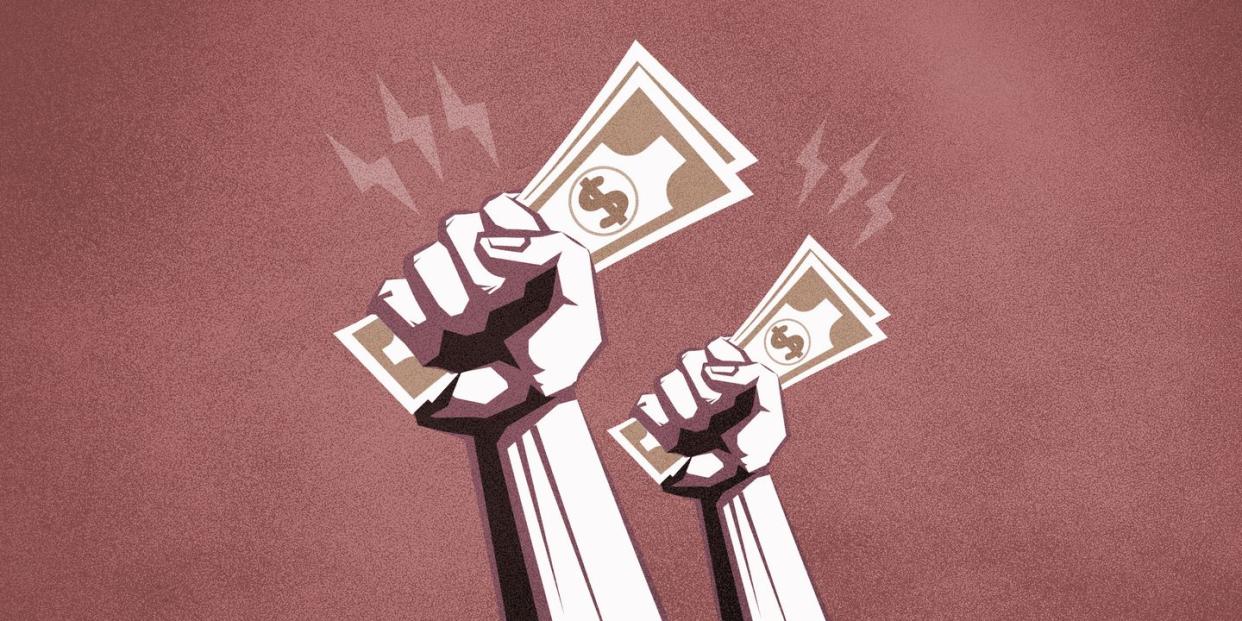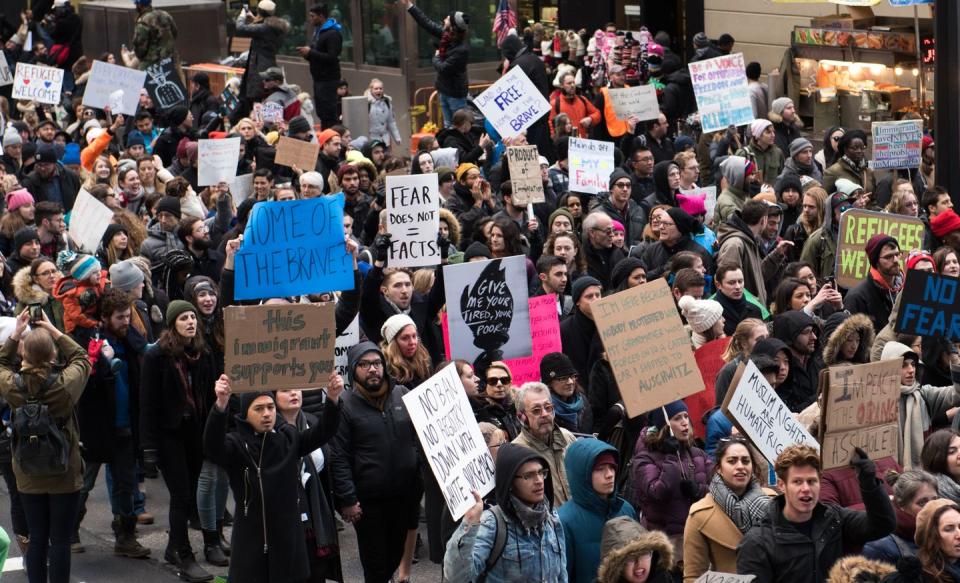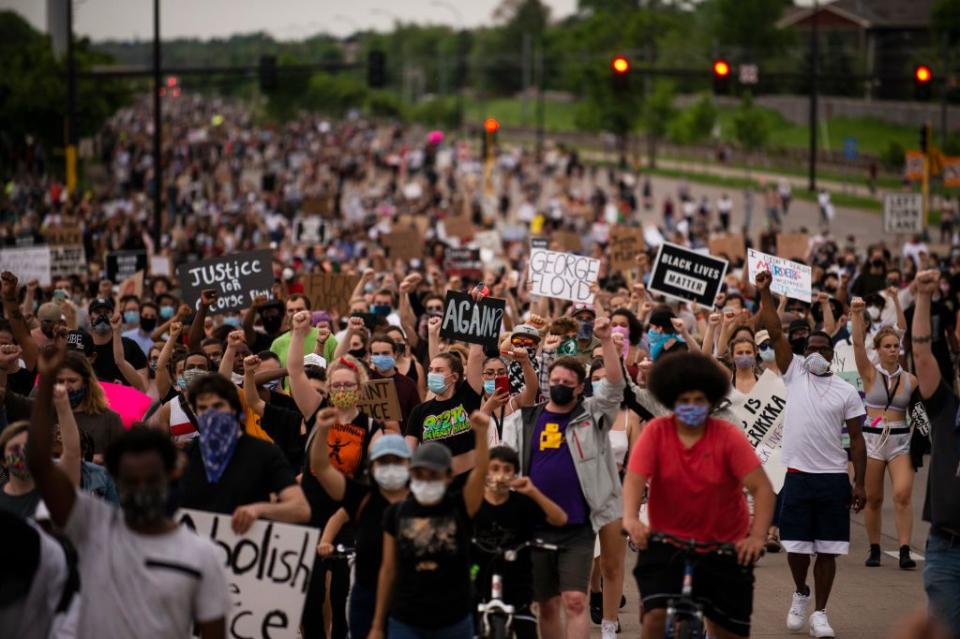How Rage Giving Became Philanthropy’s New Normal

"Hearst Magazines and Yahoo may earn commission or revenue on some items through the links below."
When the news feels overwhelmingly terrible—a school shooting, an antisemitic attack on a synagogue, a surge in the world’s refugee population—it’s hard to know how to channel the feelings of despair and helplessness. But lately, many people have had the same response: Make a donation to an organization dedicated to righting whatever went wrong.
Individuals are increasingly turning to a philanthropic phenomenon scholars have deemed “rage giving.” Rage givers typically donate in small sums ($5 or $10), are first-time donors to the organization, and are donating as much to make a statement as to make a difference.
According to a report on the phenomenon published by the Association of Fundraising Professionals (ATP), the experience of rage giving is almost always sparked by a divisive political moment, fueled by extensive media coverage around said moment, and characterized by a sudden, unexpected increase in donations and a strong emotional response in donors.
Historically, philanthropy wasn’t about intense feelings of anger or outrage. People typically gave to charity as a sense of duty, or because they were passionate about the cause. That is definitively not the case in rage giving. “The rage gift is actually a form of political protest,” says Dr. Jennifer Taylor, who studies donor psychology, “a charitable donation motivated by dissatisfaction with the political climate.”
Giving in response to bad news is not exactly new; humanitarian groups and disaster-relief organizations have always fundraised in the aftermath of catastrophe. But rage giving, Taylor says, is “unique and distinct from other types of giving.” Taylor, who co-authored Rage Giving with Katrina Miller-Stevens for Cambridge University Press, first noticed this phenomenon during the 2016 election. Rage donors, she explains, are dissatisfied with something happening in politics or the world, and thus compelled to do something—in part because they actually believe it can make a difference, and in part to get rid of those negative feelings. Taylor calls rage giving a form of effective altruism, a concept that advocates using “evidence and reason to figure out how to benefit others as much as possible.”
One doesn’t have to look very far to find examples. Take the May 2022 leak of the Supreme Court’s draft decision to overturn Roe v. Wade: donations to Planned Parenthood immediately surged. “In the week immediately following the leaked draft opinion [on Dodds v. Jackson Women’s Health Organization], we saw a 20-fold increase in new supporters and a more than 110% increase in people seeking information from Planned Parenthood’s websites,” Adrienne Verrilli, Planned Parenthood’s Vice President of Communications, tells Town & Country.

Or go back a few years: rage givers were behind waves of donations to the ACLU in the aftermath of the Trump administration’s “Muslim Ban” in January 2017. In just one week, the organization raised over $24 million—and two-thirds of the donors were first-time donors to the ACLU. Similarly, after news of family separations at the U.S.-Mexico border in June 2018, a Facebook fundraiser for a small Texas legal charity, Refugee and Immigrant Center for Education and Legal Services (RAICES) went viral to “reunite an immigrant parent with their child.” They quickly surpassed their $1,500 goal; the Facebook fundraiser brought in nearly $21 million alone, allowing RAICES to vastly expand their resources and advocacy. Rage giving at its finest.
Nonprofits all over the political spectrum benefit from rage giving. In the aftermath of the Sandy Hook school shooting, the NRA “had a record fundraising cycle,” according to The Trace, a nonprofit newsroom dedicated to reporting on gun violence. The anti-abortion group Susan B. Anthony List raised $20 million in the two months following the news that the Supreme Court would be ruling on abortion—many multiples of their average donation rate.
It’s not just domestic issues—in the immediate aftermath of the Russian invasion of Ukraine, the Hebrew Immigrant Aid Society (HIAS)—an organization dedicated to protecting refugees—launched a Ukraine crisis response, and to date, has raised $29 million, in donations that range from small mail-in gifts through a donation made by Prince Harry and Meghan Markle’s Archwell foundation. “We’ve tried to anticipate these kinds of disasters, to the extent anyone can,” Miriam Feffer, HIAS’s Vice President of Development, tells Town & Country. HIAS even set up an emergency department in recent years, which they have activated numerous times, including to help resettle Afghan refugees after the Taliban takeover of Afghanistan in summer 2021.
HIAS experienced rage giving—what they call “crisis donors”—to an “overwhelming” degree in the aftermath of the Pittsburgh synagogue shooting in October 2018, when a gunman entered Shabbat services at the Tree of Life*Or L'Simcha Congregation and killed 11 elderly worshippers—the deadliest antisemtiic attack ever in the United States.

It quickly surfaced that the gunman posted antisemitic comments about HIAS on his social media account immediately preceding his attack. “As an organization that’s historically Jewish, we saw a different set of names start popping up on our donor list,” Feffer says. “We understood that they were one-time crisis donors; they were responding to an event they saw in the news, they wanted to make a statement about their values and about their support for refugees.”
“As far as we see it, crisis donors turn to philanthropy to work through grief, horror, sadness, anger, disappointment, even disgust—and charitable giving provides an opportunity to metabolize those difficult feelings into action,” Feffer continues. “They donated to pivot from a sense of helplessness to concrete action.”
Feffer views rage giving as a positive for both the givers and the recipients. “Giving during a time of crisis can be a healthy and empowering action step that assures donors they have some power to shape the world around them,” she says. “You feel like there is a complete loss of control and sense in the world, taking that step [to donate] is a way to return to yourself as agentive, as intentional, and as someone who truly can exert some change. None of us is ever gonna solve all the problems of the world, but making one gift can both make a statement and actually take some action.”
Yet, being the recipient of rage giving isn’t always a positive thing for nonprofits—especially smaller organizations without the proper infrastructure to handle a massive influx of gifts. That’s exactly what happened to the Minnesota Freedom Fund (MFF), an organization that pays criminal bail and immigration bonds for those who cannot otherwise afford to. In May and June 2020, in the wake of the murder of George Floyd, MFF received an unprecedented $30 million in small donations in just two weeks from over one million individual donors.
“It was really scary, to be frank,” says Mirella Ceja-Orozco, the co-executive director of MFF. “At the time, we were a very small organization of one full-time staff and a working board of eight. Following the murder of George Floyd, all of a sudden, awe were noticing a bombardment of emails and money coming in. We didn't understand where it was coming from.”

The organization had never dealt with that type of money or attention before. They quickly felt immense pressure, Ceja-Orozco recalls, and took their donate button off their website. “Normally you're cultivating relationships, you're able to work with your donors because they have a particular cause that they want to support.” In this case, people donated before educating themselves on MFF, and then became annoyed that the mission or policies did not fit with their assumptions. “The way in which we received money so fast in such a short amount of time, and because of all this massive attention…we had people who claimed that they were supporting us, but now also upset with us.”
“It changed our lives, and it’s changed the lives of many Minnesotans,” Ceja-Orozco continues. “We are now able to support so many more people on a different scale. However, part of what we’ve learned is the importance of educating people and helping them understand what it means to work with an organization such as ours.”
Her advice for any organization that suddenly finds itself in the eye of a rage giving storm? “I remember how traumatized I became, because I was scared, like physically scared, to open my email,” Ceja-Orozco recalls. (MFF’s staff started getting death threats as the group’s profile grew.) “It's okay to take a step back and take a deep breath, and take the time to figure out: ‘What do we need immediately to preserve the integrity of our organization and what we're working on, but also to handle this immense responsibility?’” For MFF, that meant hiring an accountant and strategizing with their bank, “because we knew [all] this money was coming and we didn't know when it would stop, and we couldn't risk losing it or harming someone because we didn't handle it correctly.”
Turning rage givers into something more sustainable is challenging for nonprofits. For Feffer and HIAS, after the immediate crisis subsided, there was an opportunity to educate. “People are coming out of something deeply negative—they're coming because they feel sorrow or pity, to put it really bluntly. And then we turn to the affirmative chapter,” she explains, and introduce donors to the work HIAS does and their impact on displaced people worldwide.

“We believe that learning about the work itself is a powerful antidote to bigotry and fear. It helps people see the positive difference being made. And that, to us, is a chance to not only cement those relationships, but to really provide a sense that we're all making a difference together,” Feffer says. She also notes it’s important to recognize that some people will just be one-time crisis donors, and that’s okay, too. An organization can’t expect to turn all crisis donors into sustaining donors.
But nonprofits should start thinking about that transition, because rage giving isn’t going away anytime soon. A politically polarized climate, combined with the rise of viral posts on social media—making it easier than ever to be connected to a variety of organizations—has laid the groundwork for the rise of rage giving.
Nonprofits, Taylor says, “have a responsibility—almost a moral responsibility to their mission as an organization— to be ready for this. They need to strategize, they need to come up with a plan, they need to think about how they can scale multiple small gifts into real change.”
You Might Also Like

